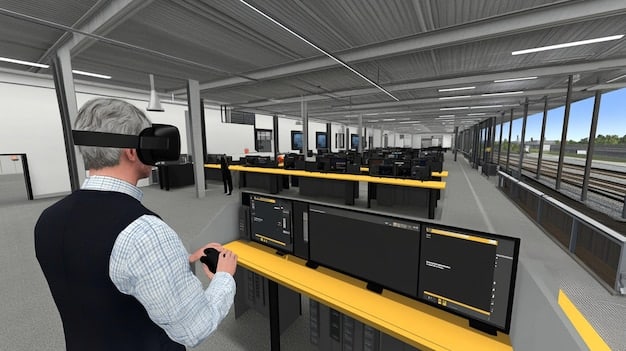The Evolution of Transportation Management Systems (TMS) in the US

Transportation Management Systems (TMS) in the US have evolved from basic freight management tools to sophisticated platforms integrating real-time data, automation, and advanced analytics to optimize supply chain operations.
The landscape of transportation and logistics in the United States has undergone a dramatic transformation over the past few decades. At the heart of this evolution lies the development and refinement of Transportation Management Systems (TMS) in the US, critical software solutions that streamline and optimize the movement of goods from origin to destination.
A Brief History of TMS
Transportation Management Systems weren’t always the sophisticated tools we know today. They began as simple ways to manage freight costs and track shipments. Understanding their origin helps us appreciate how far they’ve come.
Early Stages of TMS
Initially, TMS solutions were primarily focused on basic functions. These included freight bill auditing, route planning, and carrier selection. They provided a rudimentary level of visibility into the transportation process, mainly relying on manual data entry and limited communication capabilities.
- Freight bill auditing: Ensuring accurate billing from carriers.
- Route planning: Determining the most efficient routes for shipments.
- Carrier selection: Choosing the best carrier based on rates and service.
As businesses recognized the potential for greater efficiency, TMS began to evolve. The incorporation of technology such as electronic data interchange (EDI) allowed for a more streamlined exchange of information between shippers and carriers.

Key Milestones in TMS Development
The development of TMS has accelerated over time. It’s crucial to look at certain milestone advancements that molded the capabilities of modern TMS software.
Integration of Real-Time Data
A critical advancement was the integration of real-time data. GPS and telematics devices allowed for real-time tracking of shipments and vehicles. This data provided unprecedented visibility into the transportation process, allowing businesses to proactively address potential issues and optimize routes on the fly.
Mobile technology also played a significant role, enabling drivers to communicate updates and receive instructions in real-time. This improved communication and collaboration across the supply chain greatly.
The Rise of Cloud-Based TMS
Cloud-based TMS solutions have democratized access to advanced transportation management capabilities. By eliminating the need for expensive on-premises hardware and software, these solutions have made TMS accessible to small and medium-sized businesses.
- Lower upfront costs: Reduced investment in hardware and software.
- Scalability: Ability to easily scale resources up or down as needed.
- Accessibility: Access TMS from anywhere with an internet connection.
These advantages have made cloud-based TMS the preferred choice for many organizations, fostering even broader adoption of TMS technology.
The evolution and development of important key milestones helped TMS development become what it is today.
Current Trends in TMS Technology
The modern TMS landscape is dynamic, driven by new technologies. Keeping abreast of these trends allows users to better leverage TMS to its full potential.

Artificial Intelligence and Machine Learning
AI and machine learning are transforming TMS by automating tasks and improving decision-making. These technologies can analyze vast amounts of data to identify patterns, predict demand, and optimize routes. AI-powered TMS can also help businesses identify and mitigate risks, such as delays and disruptions.
Moreover, AI is enhancing predictive maintenance, ensuring vehicles are serviced proactively to minimize downtime and improve overall fleet efficiency. TMS with incorporated AI helps business operations.
Sustainability Initiatives
Sustainability has become a major focus in the transportation industry. Modern TMS solutions include features that help businesses reduce their carbon footprint. These might involve optimizing routes to minimize fuel consumption and integrating alternative fuel options.
- Route optimization: Minimizing fuel consumption and emissions.
- Carbon footprint tracking: Monitoring and reporting on environmental impact.
- Integration with alternative fuel networks: Facilitating the use of electric or hybrid vehicles.
Sustainability initiatives help businesses remain economically viable while being environmentally friendly.
The incorporation of AI and a larger focus on sustainability have allowed for a modern TMS system to arise.
The Impact of TMS on Supply Chain Efficiency
TMS directly influences supply chain efficiency. By enhancing visibility, automating processes, and providing data-driven insights, the entire supply chain becomes far simpler to manage.
Enhanced Visibility
Real-time tracking and monitoring capabilities provided by modern TMS greatly improve visibility across the supply chain. Businesses can see exactly where their shipments are at any given time, enabling proactive management of potential issues. This heightened visibility reduces uncertainty and improves decision-making, giving supply chain managers more control over their operations.
This also allows for better coordination between different stakeholders in the supply chain, from suppliers to carriers to customers.
Automation of Key Processes
TMS automates many of the manual, time-consuming tasks associated with transportation management. This can include tasks such as freight bill auditing, carrier selection, and shipment tracking.
- Reduced manual errors: Minimizing the risk of human error in data entry and processing.
- Faster processing times: Accelerating key processes such as freight payment and shipment tracking.
- Improved resource allocation: Freeing up staff to focus on more strategic tasks.
Automation improves operational efficiency by reducing the need for manual intervention and streamlined workflows.
TMS directly causes improvements in key processes, like automation, to improve the efficiency of data driven tasks.
Challenges and Opportunities in TMS Adoption
Despite the numerous benefits of TMS, some challenges come with implementing and using it. Understanding these challenges positions businesses to overcome them effectively. There also exist opportunities for growth given certain conditions.
Integration with Existing Systems
One of the most common challenges facing businesses adopting TMS is integrating it with existing systems, such as enterprise resource planning (ERP) and warehouse management systems (WMS). Smooth integration is essential to ensure data flows seamlessly between different parts of the organization.
However, integration can be complex and time-consuming, requiring careful planning and execution. Standardized APIs and data formats are critical to facilitating integration and minimizing disruption.
Data Security and Privacy
As TMS solutions handle sensitive data, security and privacy are paramount. Businesses must implement robust security measures to protect against unauthorized access and data breaches. TMS vendors should adhere to strict security standards and provide features such as encryption and access controls.
- Compliance with data privacy regulations: Ensuring compliance with GDPR and other relevant regulations.
- Regular security audits: Conducting periodic assessments to identify and mitigate vulnerabilities.
- Employee training: Educating employees on best practices for data security and privacy.
By addressing these challenges proactively and mitigating the risks, businesses can safely use and leverage the benefits of a TMS.
Future Directions for TMS
TMS is expected to continue its evolution in the future. Emerging trends and capabilities are set to reshape how businesses solve their transportation issues. Forecasting what’s on the horizon might allow you to better use TMS in the future.
Blockchain Technology
Blockchain technology has the potential to transform TMS, providing a tamper-proof and transparent ledger of transactions and events across the supply chain. It allows shippers, carriers, and other stakeholders to share information securely and efficiently.
Blockchain can also facilitate smart contracts that automate key processes such as payment and dispute resolution, reducing the need for manual intervention and accelerating transaction times.
Autonomous Vehicles
With continued progress, self-driving vehicles present great opportunities for streamlining long-distance hauling and last-mile delivery. TMS can be integrated with autonomous vehicle systems to optimize routes, schedule maintenance, and manage fleets more efficiently.
- Integration with autonomous vehicle platforms: Facilitating communication and coordination between TMS and autonomous vehicles.
- Real-time monitoring of autonomous vehicle operations: Tracking the location, condition, and performance of autonomous vehicles.
- Optimization of routes and schedules for autonomous vehicles: Maximizing efficiency and minimizing costs.
Autonomous vehicles and blockchain technologies have a great future for TMS.
| Key Point | Brief Description |
|---|---|
| 🚚 Early TMS | Focused on basic functions like freight auditing and route planning. |
| ☁️ Cloud TMS | Democratized access, reducing costs and enhancing accessibility. |
| 🤖 AI & ML | Automate tasks, improve decision-making, and mitigate risks. |
| ⛓️ Blockchain | Offers secure and transparent ledger for supply chain transactions. |
Frequently Asked Questions
▼
A TMS is a software solution designed to manage and optimize transportation operations, from planning and execution to freight payment and analytics.
▼
TMS improves efficiency by enhancing visibility, automating processes, and providing data-driven insights for better decision-making throughout the supply chain.
▼
Key benefits include reduced transportation costs, improved delivery times, better customer service, and enhanced visibility into the entire transportation process.
▼
Common challenges include integrating TMS with existing systems, ensuring data security and privacy, and providing adequate training for employees on how to use the new system.
▼
AI and machine learning are transforming TMS by automating tasks, analyzing data, predicting demand, optimizing routes, and helping businesses mitigate risks effectively.
Conclusion
The evolution of Transportation Management Systems (TMS) in the US tells a story of constant improvement and adaptation. From simple tools for managing freight costs to sophisticated platforms powered by AI and blockchain, TMS has become indispensable for businesses looking to optimize their supply chain operations. As technology continues to advance, TMS is poised to play an even greater role in shaping the future of transportation and logistics.





